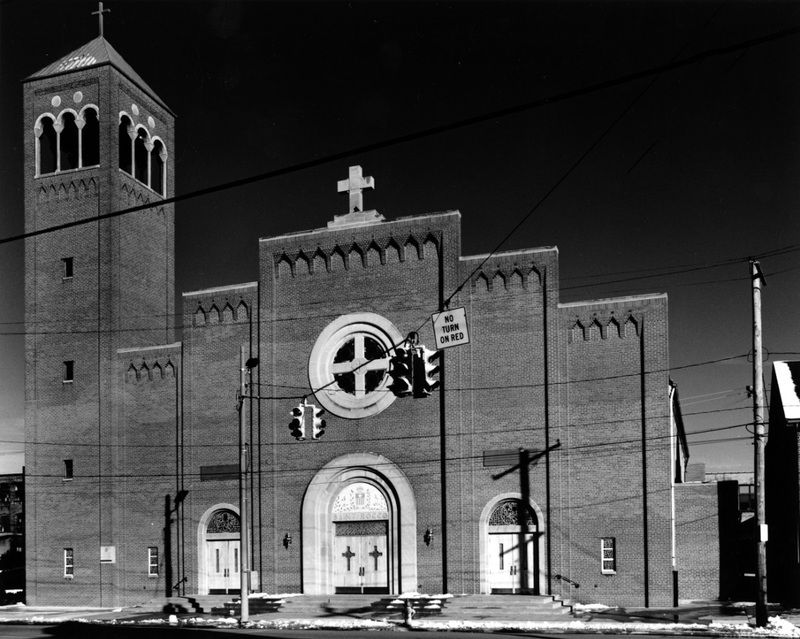
It's not unusual to hear of stories where nineteenth or twentieth century working class immigrants scrimped, saved, and did without in order to raise funds to build some of Cleveland's grandest and most enduring sacred landmarks. What is unusual, however, is to learn about a parish where such immigrants did not just scrimp and save, but also actually built the sacred landmark themselves.
In a 1964 article, the Cleveland Plain Dealer called St. Rocco the "Do-It-Yourself" parish. It was an apt nickname for the Italian parish, which celebrated its centennial in 2014, because of the numerous self-build projects it had undertaken over the years, including construction of the current church in the years 1949 to 1952.
Almost from the start, self-building became a feature of the parish. In 1914, a group of immigrants from the village of Noicattaro in the Apulia region of southern Italy, living in and around Fulton Road and Trent Avenue, met in the grocery store of fellow immigrant John Zaccaro and undertook to establish the first Italian parish on the west side. Believing that building a church would lead to diocesan recognition, they self-built a small brick structure in 1917-1918 on a single lot of land on Trent Avenue, just a stone's throw away from today's Fulton Road campus. The church was named St. Rocco, after the patron saint of the sick, who was especially venerated in southern Italy. Despite their effort, the parish was not officially recognized until 1922, when Cleveland Bishop Joseph Schrembs appointed Father Alphonse Di Maria, the assistant pastor at St. Anthony Italian Church in downtown Cleveland, as the first pastor.
In 1924, the Order of the Blessed Virgin Mary of Mercy (Mercedarian Order) was given charge of the parish and Father Sante Gattuso, a priest from Sicily, appointed second pastor, replacing Father Di Maria, who had resigned for health reasons. Father Gattuso would serve as pastor for the next 42 years. By the time of his appointment, immigrants from Faeto in the Apulia region, Guilianova in the central region, Laganadi in the Calabria region, Floridia in Sicily, and from other villages in southern and central Italy had become members of the fledgling parish. Immigrants from Trento and other towns in northern Italy began joining the parish later in the decade. Father Gattuso almost immediately embarked upon an ambitious building plan for the fast-growing parish. He purchased land on the east side of Fulton Road, south of Clark Avenue, and hired a contractor who in 1926 built a new and larger church with attached school building on the new Fulton Road campus.
In the decade of the 1930s, as the Great Depression crippled the American economy, St. Rocco parish began self-building again. In 1933, the parish self-built an addition to the school and then in 1935 one to the parish house. In 1940, Father Gattuso planned for the parish to build a new and larger church, but World War II intervened. During the war years, the men of the parish--many of them working in the building trades--saved bricks and other materials from building sites, literally creating a brick yard on the church campus. In 1949, construction of the new church finally began. Scores of parishioners volunteered their time, the men excavating, erecting the superstructure, and doing the masonry work, while women brought home-cooked meals to the site. Even retired parishioners contributed. Michael Girardi, Gaetano Farrugia, and Gennaro Di Pasquale, all elderly immigrants from southern Italy, were singled out for special recognition and became known as the Three Musketeers. In 1952, when the church was completed, Father Gattuso estimated that the labor donated by the parish had saved the church hundreds of thousands of dollars.
In the years that followed, additional self-build projects were undertaken by the parish, especially in the decade of the 1950s. In 1955, interior decorations were made to the church. The following year, the old church was converted into a gym for school children. In 1957, a memorial to the members of the parish who had served in World War II was built and, later in the same year, the grade school was remodeled. In 1959, parishioners constructed a one-story addition onto the school. The parish continued to undertake self-build projects throughout the remaining decades of the twentieth century, helping to defray the cost of maintaining an inner city church. Perhaps its history of self-building is one reason why St. Rocco Church is, and will likely always remain, a fixture and one of the most important community assets in the Clark-Fulton neighborhood.
Audio
Images











